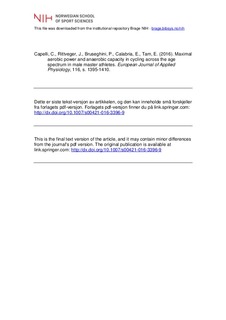| dc.contributor.author | Capelli, Carlo | |
| dc.contributor.author | Rittveger, J. | |
| dc.contributor.author | Bruseghini, Paolo | |
| dc.contributor.author | Calabria, E. | |
| dc.contributor.author | Tam, Enrico | |
| dc.date.accessioned | 2017-05-03T13:00:54Z | |
| dc.date.available | 2017-05-03T13:00:54Z | |
| dc.date.issued | 2016-05 | |
| dc.identifier.citation | European Journal of Applied Physiology. 2016, 116, 1395–1410 | nb_NO |
| dc.identifier.uri | http://hdl.handle.net/11250/2441563 | |
| dc.description | I Brage finner du siste tekst-versjon av artikkelen, og den kan inneholde ubetydelige forskjeller fra forlagets pdf-versjon. Forlagets pdf-versjon finner du på link.springer.com / In Brage you'll find the final text version of the article, and it may contain insignificant differences from the journal's pdf version. The definitive version is available at link.springer.com | |
| dc.description.abstract | Purpose: We analyzed the best performance times of master cycling athletes in the 200–3000 m track competitions to estimate the decay of maximal aerobic power (MAP) and anaerobic capacity (AnS) with aging. Methods: In various decades of age (30–80 years), MAP and AnS were estimated using an iterative procedure as the values that minimize the difference between: (1) the metabolic power (E ˙ (t) E˙(t)) necessary to cover a given distance (d) in the time t and; (2) the maximal metabolic power (E ˙ max (t) E˙max(t)) maintained at a constant level throughout the competition. Results: MAP started decreasing at 45 years of age. Thereafter, it showed an average percent rate of decrease of about 16 % for decade, as previously shown in other classes of master athletes. In addition, AnS seemed to decay by about 11 % every 10 years from the second part of the fifth decade. Conclusions: The decay of MAP occurred in spite of the active lifestyle of the subjects and it may be attributed to the progressive impairment of maximal O2 delivery and/or of peripheral O2 utilization. The loss of AnS might derive from the progressive loss of muscle mass occurring after the fifth decade of life, to the progressive qualitative deterioration of the anaerobic energy yielding pathways or to the lower capacity of MN recruitment during maximal efforts. The proposed approach may be applied to other types of human locomotion of whom the relationship between performance t and E ˙ (t) E˙(t) is known. | nb_NO |
| dc.language.iso | eng | nb_NO |
| dc.publisher | SpringerLink | nb_NO |
| dc.subject | master athletes | nb_NO |
| dc.subject | maximal aerobic power | nb_NO |
| dc.subject | anaerobic capacity | nb_NO |
| dc.subject | cycling | nb_NO |
| dc.subject | ageing | nb_NO |
| dc.title | Maximal aerobic power and anaerobic capacity in cycling across the age spectrum in male master athletes | nb_NO |
| dc.type | Journal article | nb_NO |
| dc.type | Peer reviewed | nb_NO |
| dc.subject.nsi | VDP::Matematikk og Naturvitenskap: 400::Basale biofag: 470 | nb_NO |
| dc.source.journal | European Journal of Applied Physiology | nb_NO |
| dc.identifier.doi | 10.1007/s00421-016-3396-9 | |
| dc.description.localcode | Seksjon for fysisk prestasjonsevne / Department of Physical Performance | nb_NO |
